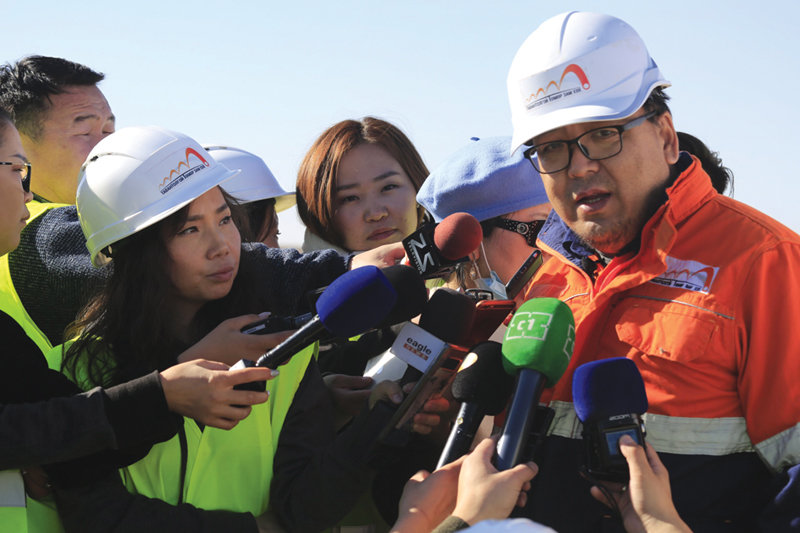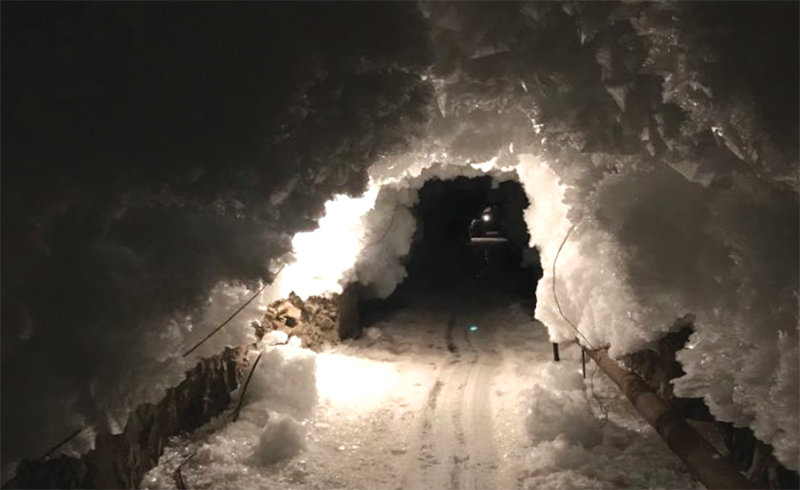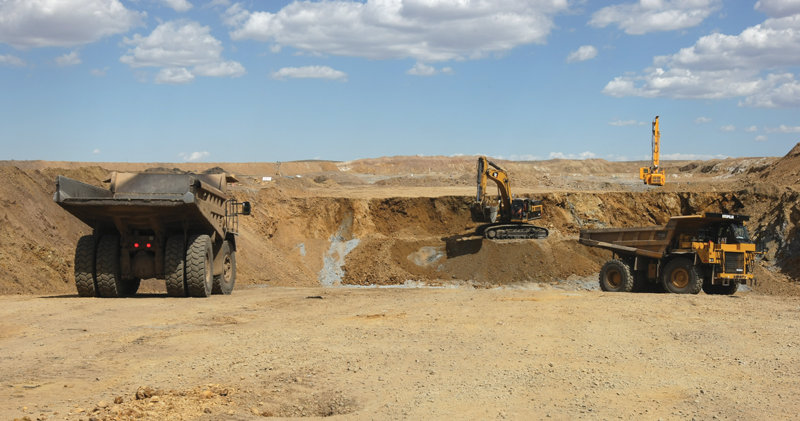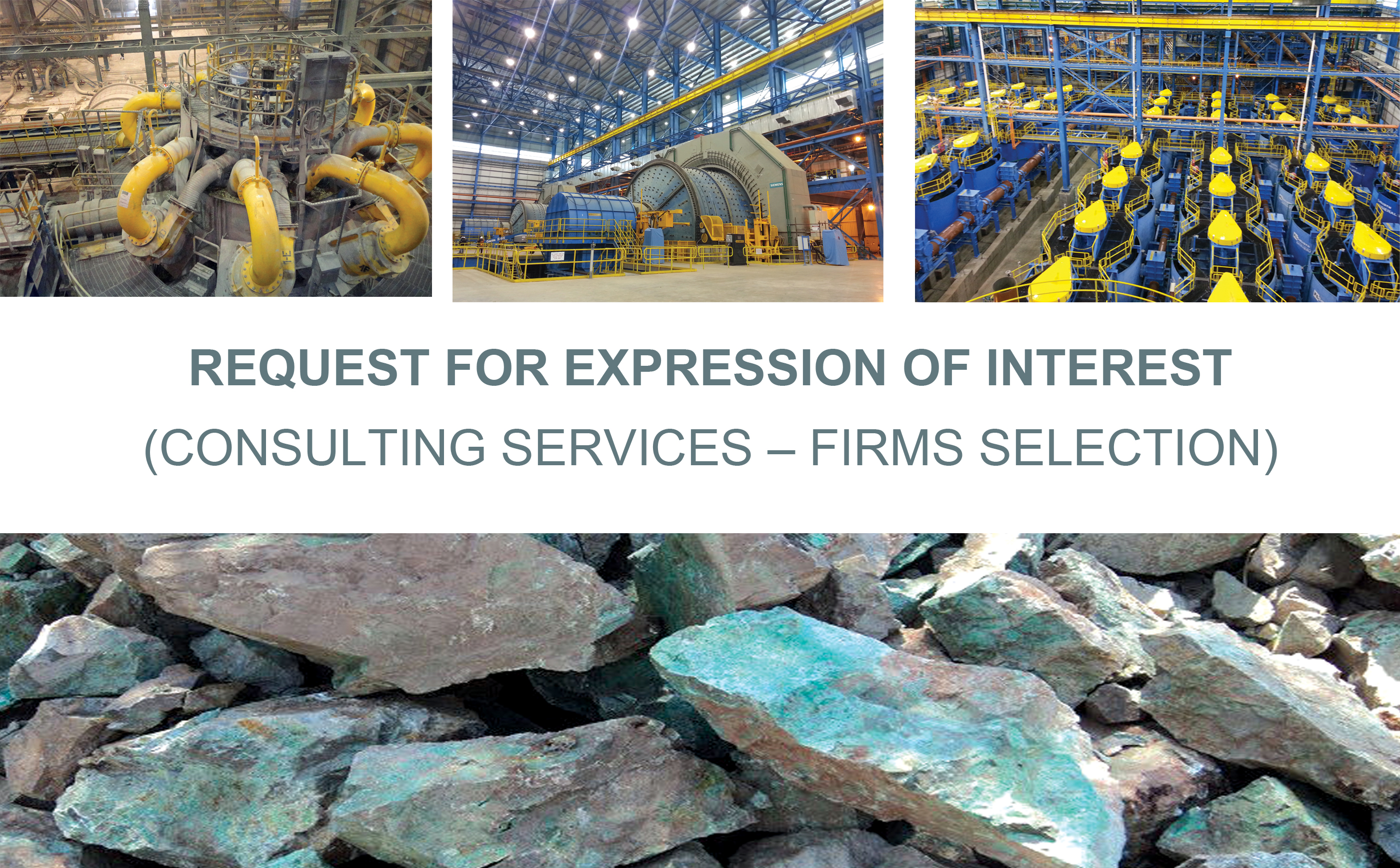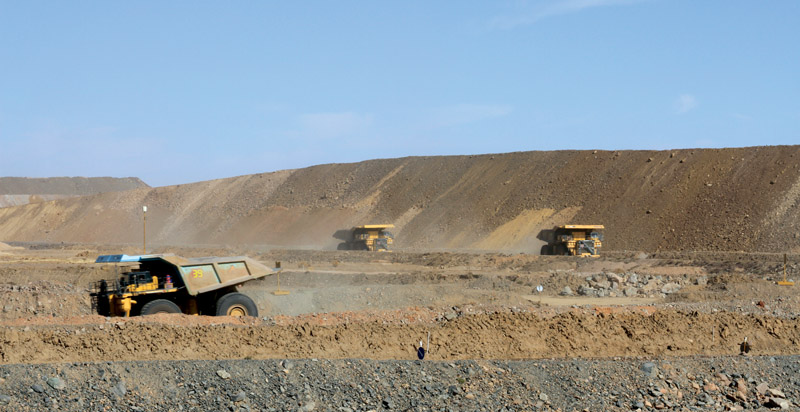Mine
Building Mongolia’s railway of hope
Trucks with some cover over their cargo of coal move at speed in a seemingly unending line along the road to Gashuunsukhait. Not all make it to the border, though, as accidents are common on the often potholed road, but the overturned or otherwise affected trucks are quickly moved to a side so as not to impede the flow. There is a similar flow in the reverse direction of empty trucks returning from the southern border. The road is kept clear for the economically important traffic, but there is garbage of all kinds on the sides, with the lighter stuff blown in all directions by the wind. Everything is made dark by the dust from the coal and the soil dispersed by the heavily laden trucks. This is how the lifeline of our coal export has been like for the past several years, as we have watched in dismay a decade pass by with much talk and more politics but no progress on the ground on building the TT-GS railway.
How miners are being successfully protected
With the number of locally transmitted cases rising, the mining sector is also in a vulnerable situation, but as it is the mainstay of the national economy, the government is determined that normal mining operations are not interrupted. Special efforts are being made to keep the virus away from Umnugovi aimag, Mongolia’s mining hub. A “green zone” has been demarcated near the border and there are also “safety zones”, intended by the Government to protect all inside them from the risk of being exposed to the virus. A working group headed by O.Batnairamdal, Deputy Minister of Mining and Heavy Industry, is camping in the mining zone to supervise strict compliance with the infection control regime put in place, so that mining does not stop and export continues.
“Pandemic or not, mining cannot stop”
D.Enkhbold, Executive Director of the Mongolian National Mining Association, tells MMJ that if mining were to stop, the country would be crippled. He also details how the sector is getting used to the restrictive regulations during a state of emergency.
What is the situation in the mining sector at a time of strict quarantine and a state of emergency?
There is no way work in the mining sector can stop even after we have local cases of the infection. If it stops, all 21 aimags and Ulaanbaatar will run out of fuel and electricity. At the same time, if exports stop, the country’s economy will collapse. Each mine is implementing a safety regimen to prevent the spread of the virus. Most companies had already prepared an action plan for this situation.
Court ruling used to change width of TT-GS railway gauge
What with the pandemic and the excitement over the election, an important decision taken by the last Parliament just before its final session ended did not receive adequate attention. Following a Constitutional Court decision that Resolution #64 adopted by Parliament in 2014 had violated the Constitution it was resolved that the 267-km Tavantolgoi-Gashuunsukhait (TT-GS) railroad would have a broad gauge, thus closing a debate that had been going on for years.
COVID-19 and mining outside Mongolia
One after another, mining companies around the world -- big or small – have been announcing since mid-March temporary suspension of their operations or, in some cases, reduction of production. The decisions were taken as governments worldwide imposed total or partial lockdown of their national economy in an attempt to contain the spread of COVID-19. Almost everywhere all non-essential activities were suspended. Mining provides many essential items of daily use, but it was defined as non-essential in countries such as Mexico and Peru, though Australia, Argentina, Brazil and Chile were among those which did not follow suit. Jurisdictions like Quebec shut down mining as a non-essential activity but made a volte face only weeks later.
CHOICE OF TECHNOLOGY IS THE MAIN DIFFICULTY FOR MINING THE ASGAT DEPOSIT
Sales revenue from the Salkhit and Asgat silver deposits would be used to compensate the loss to the exchequer from the writing off of pensioners’ loans, but will there be any revenue from Asgat at all in the near future, given that the appropriate technology for extraction there has not been identified? Nobody knows if there has been a breakthrough, but it seems unlikely.
Two other hurdles stand in the way of any quick start to sales from Asgat. First, it is about 3000 m above sea level and there is no infrastructure. Second, there are no processing facilities and ore is uneconomic to transport.
Mongolian Deposits of Silver reserves and resources
BAYAN-UUL
The Bayan-Uul silver-mixed metal deposit is under an exploration licence. Its central part is in Choibalsan soum of Dornod aimag, 790 km from Ulaanbaatar, some 20 km from the Khavirga border checkpoint and 27 km from the Khavirga railway relay of the Choibalsan-Ereentsav railway station. Geologically it is part of the Tsav ore node and is 25 km east from the Tsav silver-mixed metal deposit which is currently under mining.
Prospecting on 1:500000-1:200000 scales was taken up in 1975 by a Mongolia Geological Mapping Expedition team of the Geological Ministry of the former Soviet Union. This led to the preparation of a geological map, and the discovery of the Tsav ore node, the Tsav and Bayan-Uul silver and mixed metals deposits, as well as of the Salkhit, Modot, Altantolgoi and Omnod occurrences. Parts in these were identified where further detailed work was to be done.
How to assess if mining is “responsible”
Whenever and wherever mining is discussed, the talk soon veers to responsible mining and the hope it holds for the economic, social and environmental well-being of Mongolia. However, most of us would fumble if asked to define what exactly responsible mining is. A presentation by B. Mendbayar, Head of the Internal Auditing and Monitoring Division at Erdenes Mongol and the man who worked out the assessment methodology for responsible mining in an IFC-sponsored programme, at a seminar of the Local Journalists’ Network 2019 training project, went into details of how to evaluate a company’s record in responsible mining. E. Od, who took notes, now presents what was said.
A matter of ownership
Trained as a non-ferrous metal engineer and later earning a law degree, N. Algaa was first Executive Director and then President of the Mongolian National Mining Association, before joining Dat Consulting LLC as Executive Director. The Mongolian Mining Journal has interviewed him on several occasions, and we are happy that he will be writing a series of articles for us giving his analysis of and views on developments in the minerals sector. This is the first one and was written in August.
Miners pledge to be responsible
Major companies in the extractive industry in Mongolia recently came together to launch a campaign to encourage the practice of responsible mining. Among those who attended the meeting at Tuushin Hotel were those representing Oyu Tolgoi, Erdenet Mining, Energy Resources, Aspire Mining, SouthGobi Sands, Terra Energy and Baganuur. Later, they all joined the Responsible Mining Voluntary Code.
The campaign was initiated by the Mongolian National Mining Association (MNMA) and is to be implemented together with the Ministry of Mining and Heavy Industry. Those who joined the codex and signed a memorandum of understanding (MoU) included Kh. Badamsuren, Director General of the state-owned Erdenet Mining Corporation, Armando Torres, CEO of Oyu Tolgoi, G. Battsengel, CEO of Energy Resources, Z.Gan-Ochir of Aspire Mining, Ch. Munkhbat, President and CEO of SouthGobi Sands, Sam Bowles, CEO of Terra Energy, and O.Tuya, Vice Director of Baganuur JSC. The MoU has 30 clauses in 5 sections.
REQUEST FOR EXPRESSION OF INTEREST (CONSULTING SERVICES – FIRMS SELECTION)
The Ministry of Mining and Heavy Industry of Mongolia now invites eligible consulting firms (“Consultants”) to express their interest in developing a detailed feasibility study on the construction of a copper concentrate smelting and refining plant in Mongolia. Interested Consultants shall meet the criteria and requirements specified in Articles 14, 15 and 16 of Public Procurement Law of Mongolia and submit the following documents to indicate their capacity:
New strategic deposits only to enrich Erdenes Mongol?
State-owned Erdenes Mongol is at a critical point of its life.
The working group led by L. Oyun-Erdene, Head of the Cabinet Secretariat, has given final touches to the draft law on the planned wealth fund which should be discussed at a government meeting very soon and then sent to parliament where it is expected to have an easy passage. The draft proposes to make Erdenes Mongol solely responsible for management of the fund. The company runs Mongolia’s strategic deposits which have abundant mineral resources but the question before every citizen is: can it run – or, be allowed to run -- them well enough to earn the kind of profits that would make the fund truly a wealth for future generations?
Hectic activities are on at the sectoral ministry to give more assets to Erdenes Mongol.
Asgat gets a new owner but is it ready to be mined?
On January 7, 2019, G. Zandanshatar, Head of the Cabinet Secretariat, issued directives tothe Ministry of Mining and Heavy Industry (MMHI) and the Mineral Resources and Petroleum Authority (MRPAM) to transfer the ownership of the Asgat polymetallic deposit from Mongolrostsvetmet to the state-owned Erdenes Mongol.
REQUEST FOR EXPRESSION OF INTEREST
The Ministry of Mining and Heavy Industry of Mongolia now invites eligible consulting firms (“Consultants”) to express their interest in developing a detailed feasibility study on the construction of a copper concentrate smelting and refining plant in Mongolia.
Impact of neglecting exploration will be dire
The revelation by the Mineral Resources and Petroleum Authority that for quite some time now there has been no new registration of any western investor in the exploration sector merely confirms what is common knowledge. Serious and tenacious American, Australian and Canadian investors have left Mongolia.
Mongolia waits for mega projects to move in 2019
Mongolia leads other countries in the excessive number of policies, decisions, rules and regulations around its investment climate,” emphasized Ms. Christine Zhenwei Qiang, Practice Manager for the Global Investment and Competition Unit of the World Bank Group’s Macro, Trade and Investment (MTI) Global Practice, at the Economic Forum in May.
Fate of TT power plant hinges on RIO TINTO decision
How Oyu Tolgoi LLC decides to source the electricity to meet the needs of its mine will also decide the fate of the Tavan Tolgoi power plant, a proposed mega project that would meet the power needs of both industrial and domestic users across a large swathe of the country.
Call for “win-win partnership” douses tensions, for now
Not many were convinced that the brief, and somewhat sudden, visit to Mongolia by Rio Tinto CEO Jean-Sebastien Jacques was solely or really to inaugurate on 22 January the company’s new office in Mongolia, separate from Oyu Tolgoi LLC. Such events do not usually warrant the presence of the chief executive of a global giant.
Mega wait for mega projects could end in 2018
Mongolians are happy to endlessly talk about their successes, and to rest on them. Thus it is no surprise that they are still full of how good 2017 was for the mining industry and exports revenue.
